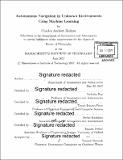| dc.contributor.advisor | Nicholas Roy. | en_US |
| dc.contributor.author | Richter, Charles Andrew | en_US |
| dc.contributor.other | Massachusetts Institute of Technology. Department of Aeronautics and Astronautics. | en_US |
| dc.date.accessioned | 2017-12-05T19:13:40Z | |
| dc.date.available | 2017-12-05T19:13:40Z | |
| dc.date.copyright | 2017 | en_US |
| dc.date.issued | 2017 | en_US |
| dc.identifier.uri | http://hdl.handle.net/1721.1/112457 | |
| dc.description | Thesis: Ph. D., Massachusetts Institute of Technology, Department of Aeronautics and Astronautics, 2017. | en_US |
| dc.description | Cataloged from PDF version of thesis. | en_US |
| dc.description | Includes bibliographical references (pages 165-175). | en_US |
| dc.description.abstract | In this thesis, we explore the problem of high-speed autonomous navigation for a dynamic mobile robot in unknown environments. Our objective is to navigate from start to goal in minimum time, given no prior knowledge of the map, nor any explicit knowledge of the environment distribution. Faced with this challenge, most practical receding-horizon navigation methods simply restrict their action choices to the known portions of the map, and ignore the effects that future observations will have on their map knowledge, sacrificing performance as a result. In this thesis, we overcome these limitations by efficiently extending the robot's reasoning into unknown parts of the environment through supervised learning. We predict key contributors to the navigation cost before the relevant portions of the environment have been observed, using training examples from similar planning scenarios of interest. Our first contribution is to develop a model of collision probability to predict the outcomes of actions that extend beyond the perceptual horizon. We use this collision probability model as a data-driven replacement for conventional safety constraints in a receding-horizon planner, resulting in collision-free navigation at speeds up to twice as fast as conventional planners. We make these predictions using a Bayesian approach, leveraging training data for performance in familiar situations, and automatically reverting to safe prior behavior in novel situations for which our model is untrained. Our second contribution is to develop a model of future measurement utility, efficiently enabling information-gathering behaviors that can extend the robot's visibility far into unknown regions of the environment, thereby lengthening the perceptual horizon, resulting in faster navigation even under conventional safety constraints. Our third contribution is to adapt our collision prediction methods to operate on raw camera images, using deep neural networks. By making predictions directly from images, we take advantage of rich appearance-based information well beyond the range to which dense, accurate environment geometry can be reliably estimated. Pairing this neural network with novelty detection and a self-supervised labeling technique, we show that we can deploy our system initially with no training, and it will continually improve with experience and expand the set of environment types with which it is familiar. | en_US |
| dc.description.statementofresponsibility | by Charles Andrew Richter. | en_US |
| dc.format.extent | 175 pages | en_US |
| dc.language.iso | eng | en_US |
| dc.publisher | Massachusetts Institute of Technology | en_US |
| dc.rights | MIT theses are protected by copyright. They may be viewed, downloaded, or printed from this source but further reproduction or distribution in any format is prohibited without written permission. | en_US |
| dc.rights.uri | http://dspace.mit.edu/handle/1721.1/7582 | en_US |
| dc.subject | Aeronautics and Astronautics. | en_US |
| dc.title | Autonomous navigation in unknown environments using machine learning | en_US |
| dc.type | Thesis | en_US |
| dc.description.degree | Ph. D. | en_US |
| dc.contributor.department | Massachusetts Institute of Technology. Department of Aeronautics and Astronautics | |
| dc.identifier.oclc | 1010818089 | en_US |
